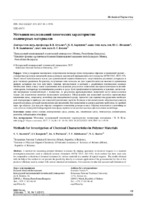| dc.contributor.author | Кузьмич, В. В. | ru |
| dc.contributor.author | Карпунин, И. И. | ru |
| dc.contributor.author | Почанин, Ю. С. | ru |
| dc.contributor.author | Балабанова, Т. Ф. | ru |
| dc.contributor.author | Козлов, Н. Г. | ru |
| dc.coverage.spatial | Минск | ru |
| dc.date.accessioned | 2017-02-01T12:16:38Z | |
| dc.date.available | 2017-02-01T12:16:38Z | |
| dc.date.issued | 2017 | |
| dc.identifier.citation | Методики исследований химических характеристик полимерных материалов = Methods for Investigation of Chemical Characteristics in Polymer Materials / В. В. Кузьмич и др. // Наука и техника. – 2017. – № 1. - С. 49 – 56. | ru |
| dc.identifier.uri | https://rep.bntu.by/handle/data/27594 | |
| dc.description.abstract | Метод измерения химического сопротивления полимера путем погружения образцов в химический реагент – стандартная процедура испытаний, используемая в химической промышленности (стандарты ASTM D543, ИСО 155). Такой способ использовался только для сравнительной оценки химического сопротивления различных материалов в ряде типичных реагентов. Результаты, получаемые этим методом, не дают прямой оценки возможности применения данного материала для того или иного изделия, используемого в контакте с различными химическими средами. Необходимо иметь в виду такие ограничения используемых результатов испытаний, как продолжительность воздействия среды, температура и концентрация реагента в среде. Если предполагается применение в условиях, когда изделие непрерывно взаимодействует с жидкостью, то результаты кратковременных испытаний могут использоваться только для исключения наименее подходящих материалов. Оборудование для испытаний включало прецизионные химические весы, микрометр, контейнер для иммерсионной среды, термостат для задания и поддержания необходимой температуры и приборы для измерений физических свойств. Размеры и тип испытуемого образца определяются формой материала, который предназначен для испытаний. При испытаниях в каждом реагенте требуются, по крайней мере, три образца. Для каждого образца измеряются изменения размеров и веса. Образец помещается в контейнер на семь суток в стандартной лабораторной атмосфере, причем он не должен касаться дна или стенок контейнера. | ru |
| dc.language.iso | ru | ru |
| dc.publisher | БНТУ | ru |
| dc.subject | Метод оценки | ru |
| dc.subject | Иммерсионная среда | ru |
| dc.subject | Химическая среда | ru |
| dc.subject | Лабораторная атмосфера | ru |
| dc.subject | Evaluation method | en |
| dc.subject | Immersion medium | en |
| dc.subject | Chemical medium | en |
| dc.subject | Laboratory atmosphere | en |
| dc.title | Методики исследований химических характеристик полимерных материалов | ru |
| dc.title.alternative | Methods for Investigation of Chemical Characteristics in Polymer Materials | en |
| dc.type | Article | ru |
| dc.relation.journal | Наука и техника | ru |
| dc.identifier.doi | 10.21122/2227-1031-2017-16-1-49-56 | |
| local.description.annotation | A method for measuring polymer chemical resistance by dipping specimens in chemical reagents is a standard investigation procedure used in chemical industry (Standards ASTM D543, ISO 155). Such method has been used only for comparative evaluation of chemical resistance for various materials in a number of typical reagents. The results obtained with the help of the method do not provide the possibility directly to estimate application of the given material for this or that products which are used in contact with various chemical environments. It is necessary to take into account such limitations of theused testing results as duration of environmental exposure, temperature and reagent concentration in the medium. If it is as sumed that the method is applied under conditions when a product is continuously contacting with liquid then the results of short-term testings can be used only with the purpose to exclude the least adequate materials. Testing equipment has included a precision chemical balance, a micrometer, a container for immersion medium, a thermostat for setting and maintaining the required temperature and devices for measuring physical properties. Dimensions and type of a test specimen are specified by the shape of material which is used for testing. At least three specimens are needed for testing in every reagent. Changes in dimension and weight are measured for every specimen. The specimen is placed in container for 7 days in standard laboratory atmosphere where it should not touch a bottom or walls of the container. | en |

